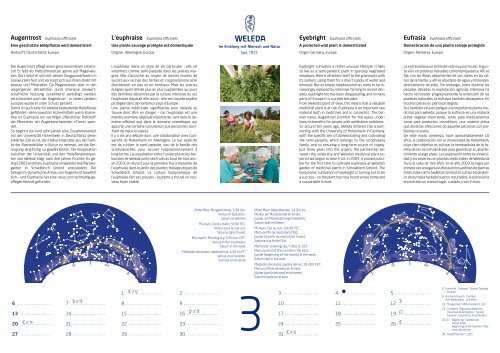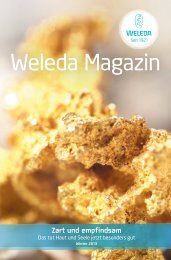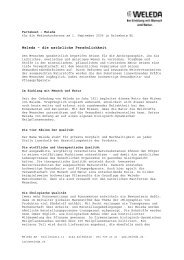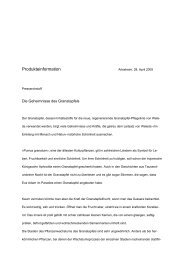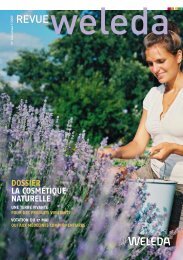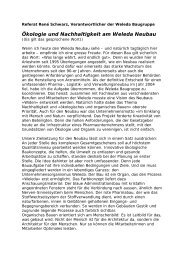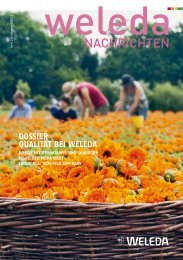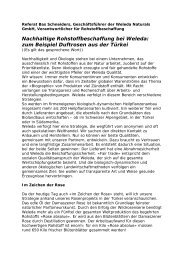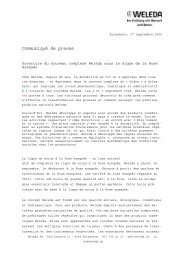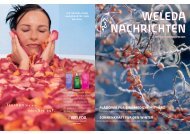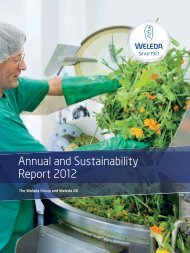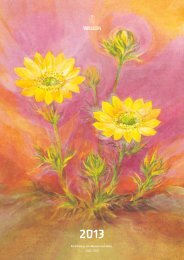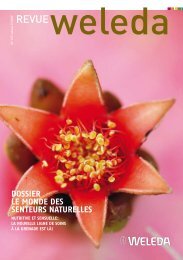You also want an ePaper? Increase the reach of your titles
YUMPU automatically turns print PDFs into web optimized ePapers that Google loves.
Augentrost Euphrasia officinalis<br />
Eine geschützte Wildpflanze wird domestiziert<br />
Herkunft: Deutschland, Europa<br />
Der Augentrost pflegt einen ganz besonderen Lebensstil:<br />
Er lebt als Halbschmarotzer gerne auf Magerwiesen.<br />
Dort setzt er sich mit seinen Saugwurzelfasern in<br />
Graswurzeln fest und versorgt sich aus ihnen direkt mit<br />
Wasser und Mineralien. Da Magerwiesen aber in den<br />
vergangenen Jahrzehnten durch intensive landwirtschaftliche<br />
Nutzung zunehmend verdrängt werden,<br />
verschwindet auch der Augentrost – in vielen Ländern<br />
Europas wurde er unter Schutz gestellt.<br />
Damit ist auch eine für <strong>Weleda</strong> bedeutende Heilpflanze<br />
gefährdet – denn sowohl in Arzneimitteln wie in Kosmetika<br />
ist Euphrasia ein wichtiger pflanzlicher Rohstoff,<br />
der Menschen mit Augenbeschwerden »Trost« spendet.<br />
So beginnt vor rund zehn <strong>Jahre</strong>n eine Zusammenarbeit<br />
mit der Universität Hohenheim in Deutschland, deren<br />
erklärtes Ziel es ist, den Halbschmarotzer aus der Familie<br />
der Rachenblütler in Kultur zu nehmen, um die Versorgung<br />
langfristig zu gewährleisten. Die Kooperation<br />
zwischen der Universität und den Heilpflanzenexperten<br />
von <strong>Weleda</strong> trägt nach drei <strong>Jahre</strong>n Früchte: Es gelingt<br />
2003 erstmals, Euphrasia im <strong>Weleda</strong> Heilpflanzengarten<br />
in Schwäbisch Gmünd anzusiedeln. Der<br />
biologisch-dynamische Anbau von Augentrost bewährt<br />
sich – und Euphrasia hat eine neue und nachhaltig gepflegte<br />
Heimat gefunden.<br />
6 ...................<br />
13 .................<br />
20 .................<br />
fFP<br />
27 .................<br />
7 ...................<br />
4Ft<br />
14 . .................<br />
21 . .................<br />
28 . .................<br />
L'euphraise Euphrasia officinalis<br />
Une plante sauvage protégée est domestiquée<br />
Origine : Allemagne, Europe<br />
L'euphraise mène un style de vie particulier : elle vit<br />
volontiers comme semi-parasite dans les prairies maigres.<br />
Elle s'accroche au moyen de racines munies de<br />
suçoirs aux racines des herbes et s'approvisionne ainsi<br />
directement en eau et en minéraux. Mais les prairies<br />
maigres ayant été de plus en plus supplantées au cours<br />
des dernières décennies par la culture intensive du sol,<br />
l'euphraise disparaît elle-aussi – elle est classée espèce<br />
protégée dans de nombreux pays d'Europe.<br />
Une plante médicinale significative pour <strong>Weleda</strong> se<br />
trouve donc être en danger – car l'euphraise est une<br />
matière première végétale importante, tant dans le domaine<br />
officinal que dans le domaine cosmétique, qui<br />
apporte une certaine consolation aux personnes souffrant<br />
de maux oculaires.<br />
Il y a dix ans débute donc une collaboration avec l'université<br />
de Hohenheim en Allemagne. Le but explicite<br />
est de cultiver le semi-parasite, issu de la famille des<br />
scrofulariacées, pour assurer l'approvisionnement à<br />
long terme. La coopération entre l'université et les herboristes<br />
de <strong>Weleda</strong> porte ses fruits au bout de trois ans :<br />
en 2003, on réussit pour la première fois à implanter de<br />
l'euphraise dans le jardin des plantes thérapeutiques de<br />
Schwäbisch Gmünd. La culture biodynamique de<br />
l'euphraise fait ses preuves – la plante a trouvé un nouveau<br />
foyer stable.<br />
1 ...................<br />
fF R<br />
8 ...................<br />
15 . .................<br />
22 . .................<br />
29 . .................<br />
Mitte März: Morgenhimmel, 5.30 Uhr;<br />
Venus im Südosten;<br />
Saturn im Westen<br />
Mi-mars: Ciel du matin, 5h30 TEC;<br />
Vénus dans le sud-est;<br />
Saturne dans l'ouest<br />
Mid-march: Morning sky, 5:30 a.m. CET;<br />
Venus in the southeast;<br />
Saturn in the west<br />
Mediados de marzo: salida del sol, 5.30 h CET;<br />
Venus en el sureste;<br />
Saturno en el oeste<br />
2 ...................<br />
9 ...................<br />
OFt<br />
16 . .................<br />
23 . .................<br />
30 . .................<br />
WELEDA<br />
Im Einklang mit Mensch und Natur<br />
Seit 1921<br />
3<br />
Mitte März: Abendhimmel, 19.30 Uhr;<br />
Merkur am Monatsende im Osten;<br />
Jupiter am Monatsanfang im Westen;<br />
Saturn spät im Osten<br />
Mi-mars: Ciel du soir, 19h30 TEC;<br />
Mercure (fin du mois) dans l'Est;<br />
Jupiter (à partir du mois) dans l'ouest;<br />
Saturne à la fin de l'Est<br />
Mid-march: Evening sky, 7:30 p.m. CET;<br />
Mercury (end of the month) in the east;<br />
Jupiter (beginning of the month) in the west;<br />
Saturn late in the east<br />
Mediados de marzo: puesta del sol, 19.30 h CET;<br />
Mercurio (final de mes) en el este;<br />
Júpiter (partir del mes) en el oeste;<br />
Saturno tarde en el este<br />
3 ...................<br />
10 ..................<br />
17 ..................<br />
24 ..................<br />
fF<br />
31 ..................<br />
R<br />
Eyebright Euphrasia officinalis<br />
A protected wild plant is domesticated<br />
Origin: Germany, Europe<br />
Eyebright cultivates a rather unusual lifestyle. It likes<br />
to live as a semi-parasitic plant in sparsely vegetated<br />
meadows. Here it attaches itself to the grassroots with<br />
its suckers, using them for a direct supply of water and<br />
minerals. But as empty meadowland has come to be increasingly<br />
replaced by intensive farming in recent decades,<br />
eyebright too has been disappearing, and in many<br />
parts of Europe it is a protected plant.<br />
From <strong>Weleda</strong>’s point of view, this means that a valuable<br />
medicinal plant is at risk. Euphrasia is an important raw<br />
material both in medicines and in cosmetics. The German<br />
name, Augentrost (comfort for the eyes), underlines<br />
its benefits for people with ophthalmic problems.<br />
So around ten years ago, <strong>Weleda</strong> entered into a partnership<br />
with the University of Hohenheim in Germany,<br />
with the specific aim of domesticating and cultivating<br />
the semi-parasite, which belongs to the scrophularia<br />
family, and so ensuring a long-term source of supply.<br />
Just three years into the project, the partnership between<br />
the university and <strong>Weleda</strong>’s medicinal plant experts<br />
had begun to bear fruit. In 2003, it proved possible<br />
for the first time to cultivate euphrasia at <strong>Weleda</strong>’s<br />
garden of medicinal plants in Schwäbisch Gmünd. The<br />
biodynamic cultivation of eyebright is turning out to be<br />
a success – so the plant has now found a new home and<br />
a sustainable future.<br />
4 ...................<br />
w<br />
11 ..................<br />
18 ..................<br />
25 ..................<br />
Eufrasia Euphrasia officinalis<br />
Domesticación de una planta salvaje protegida<br />
Origen: Alemania, Europa<br />
La eufrasia lleva un estilo de vida muy particular: le gusta<br />
vivir en praderas naturales como hemiparásita. Allí se<br />
fija, con las fibras absorbentes de sus raíces en las raíces<br />
de la hierba, y allí se abastece de agua y minerales,<br />
directamente de ellas. Sin embargo, como durante las<br />
pasadas décadas la explotación agrícola intensiva ha<br />
hecho retroceder progresivamente la extensión de las<br />
praderas naturales, la eufrasia también desaparece. En<br />
muchos países es planta protegida.<br />
Así, también está en peligro una importante planta medicinal<br />
para <strong>Weleda</strong>; porque la eufrasia es una materia<br />
prima vegetal importante, tanto para medicamentos<br />
como para productos cosméticos, una materia prima<br />
que alivia las afecciones de aquellas personas con problemas<br />
oculares.<br />
De este modo comienza, hace aproximadamente 10<br />
años, la colaboración con la Universidad de Hohenheim,<br />
cuyo claro objetivo es cultivar la hemiparásita de la familia<br />
de las escrofulariáceas para garantizar su abastecimiento<br />
a largo plazo. La cooperación entre la universidad<br />
y los expertos en plantas medicinales de <strong>Weleda</strong> da<br />
fruto al cabo de tres años: en el año 2003 se logra por<br />
primera vez arraigar la eufrasia en los jardines de plantas<br />
medicinales de Schwäbisch Gmünd. El cultivo biodinámico<br />
de eufrasia ha dado buenos resultados; la eufrasia ha<br />
encontrado un nuevo hogar, cuidado y con futuro.<br />
5 ...................<br />
4<br />
12 ..................<br />
19 ..................<br />
q<br />
26 ..................<br />
f<br />
8. Fasnacht Carnaval Shrove Tuesday<br />
Carnaval<br />
9. Aschermittwoch Cendres<br />
Ash Wednesday Le Ceneri<br />
14. Morgestraich (Alte Fasnacht, CH)<br />
21. Frühjahrs-Tagundnachtgleiche<br />
Equinoxe de printemps Spring<br />
Equinox Equinoccio de primavera<br />
26./27. Beginn der Sommerzeit<br />
Heure d'été<br />
Beginning of the Summer-Time<br />
Inicio del verano<br />
30. Rudolf Steiner † 1925


